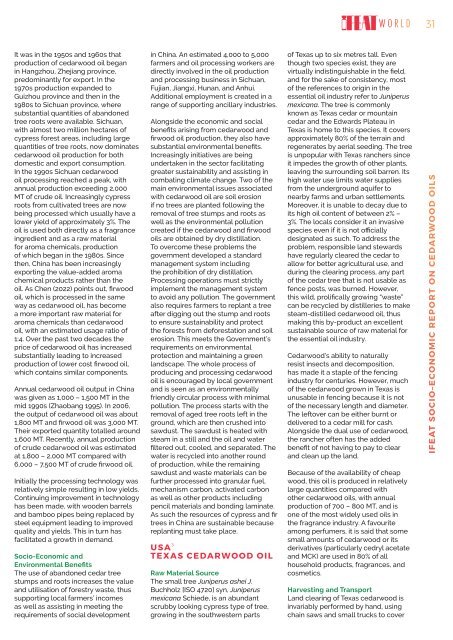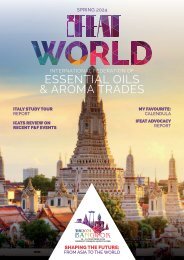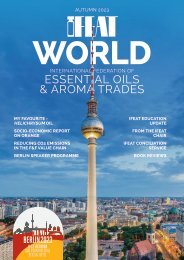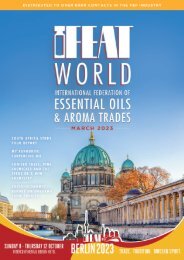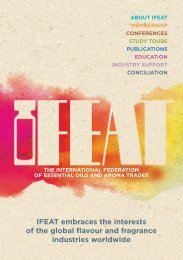IFEATWORLD July 2022
A Members' Newsletter for the International Federation of Essential Oils & Aroma Trades.
A Members' Newsletter for the International Federation of Essential Oils & Aroma Trades.
Create successful ePaper yourself
Turn your PDF publications into a flip-book with our unique Google optimized e-Paper software.
WORLD 31<br />
It was in the 1950s and 1960s that<br />
production of cedarwood oil began<br />
in Hangzhou, Zhejiang province,<br />
predominantly for export. In the<br />
1970s production expanded to<br />
Guizhou province and then in the<br />
1980s to Sichuan province, where<br />
substantial quantities of abandoned<br />
tree roots were available. Sichuan,<br />
with almost two million hectares of<br />
cypress forest areas, including large<br />
quantities of tree roots, now dominates<br />
cedarwood oil production for both<br />
domestic and export consumption.<br />
In the 1990s Sichuan cedarwood<br />
oil processing reached a peak, with<br />
annual production exceeding 2,000<br />
MT of crude oil. Increasingly cypress<br />
roots from cultivated trees are now<br />
being processed which usually have a<br />
lower yield of approximately 3%. The<br />
oil is used both directly as a fragrance<br />
ingredient and as a raw material<br />
for aroma chemicals, production<br />
of which began in the 1980s. Since<br />
then, China has been increasingly<br />
exporting the value-added aroma<br />
chemical products rather than the<br />
oil. As Chen (<strong>2022</strong>) points out, firwood<br />
oil, which is processed in the same<br />
way as cedarwood oil, has become<br />
a more important raw material for<br />
aroma chemicals than cedarwood<br />
oil, with an estimated usage ratio of<br />
1:4. Over the past two decades the<br />
price of cedarwood oil has increased<br />
substantially leading to increased<br />
production of lower cost firwood oil,<br />
which contains similar components.<br />
Annual cedarwood oil output in China<br />
was given as 1,000 – 1,500 MT in the<br />
mid 1990s (Zhaobang 1995). In 2006,<br />
the output of cedarwood oil was about<br />
1,800 MT and firwood oil was 3,000 MT.<br />
Their exported quantity totalled around<br />
1,600 MT. Recently, annual production<br />
of crude cedarwood oil was estimated<br />
at 1,800 – 2,000 MT compared with<br />
6,000 – 7,500 MT of crude firwood oil.<br />
Initially the processing technology was<br />
relatively simple resulting in low yields.<br />
Continuing improvement in technology<br />
has been made, with wooden barrels<br />
and bamboo pipes being replaced by<br />
steel equipment leading to improved<br />
quality and yields. This in turn has<br />
facilitated a growth in demand.<br />
Socio-Economic and<br />
Environmental Benefits<br />
The use of abandoned cedar tree<br />
stumps and roots increases the value<br />
and utilisation of forestry waste, thus<br />
supporting local farmers’ incomes<br />
as well as assisting in meeting the<br />
requirements of social development<br />
in China. An estimated 4,000 to 5,000<br />
farmers and oil processing workers are<br />
directly involved in the oil production<br />
and processing business in Sichuan,<br />
Fujian, Jiangxi, Hunan, and Anhui.<br />
Additional employment is created in a<br />
range of supporting ancillary industries.<br />
Alongside the economic and social<br />
benefits arising from cedarwood and<br />
firwood oil production, they also have<br />
substantial environmental benefits.<br />
Increasingly initiatives are being<br />
undertaken in the sector facilitating<br />
greater sustainability and assisting in<br />
combating climate change. Two of the<br />
main environmental issues associated<br />
with cedarwood oil are soil erosion<br />
if no trees are planted following the<br />
removal of tree stumps and roots as<br />
well as the environmental pollution<br />
created if the cedarwood and firwood<br />
oils are obtained by dry distillation.<br />
To overcome these problems the<br />
government developed a standard<br />
management system including<br />
the prohibition of dry distillation.<br />
Processing operations must strictly<br />
implement the management system<br />
to avoid any pollution. The government<br />
also requires farmers to replant a tree<br />
after digging out the stump and roots<br />
to ensure sustainability and protect<br />
the forests from deforestation and soil<br />
erosion. This meets the Government’s<br />
requirements on environmental<br />
protection and maintaining a green<br />
landscape. The whole process of<br />
producing and processing cedarwood<br />
oil is encouraged by local government<br />
and is seen as an environmentally<br />
friendly circular process with minimal<br />
pollution. The process starts with the<br />
removal of aged tree roots left in the<br />
ground, which are then crushed into<br />
sawdust. The sawdust is heated with<br />
steam in a still and the oil and water<br />
filtered out, cooled, and separated. The<br />
water is recycled into another round<br />
of production, while the remaining<br />
sawdust and waste materials can be<br />
further processed into granular fuel,<br />
mechanism carbon, activated carbon<br />
as well as other products including<br />
pencil materials and bonding laminate.<br />
As such the resources of cypress and fir<br />
trees in China are sustainable because<br />
replanting must take place.<br />
USA 3<br />
TEXAS CEDARWOOD OIL<br />
Raw Material Source<br />
The small tree Juniperus ashei J.<br />
Buchholz [ISO 4720] syn, Juniperus<br />
mexicana Schiede, is an abundant<br />
scrubby looking cypress type of tree,<br />
growing in the southwestern parts<br />
of Texas up to six metres tall. Even<br />
though two species exist, they are<br />
virtually indistinguishable in the field,<br />
and for the sake of consistency, most<br />
of the references to origin in the<br />
essential oil industry refer to Juniperus<br />
mexicana. The tree is commonly<br />
known as Texas cedar or mountain<br />
cedar and the Edwards Plateau in<br />
Texas is home to this species. It covers<br />
approximately 80% of the terrain and<br />
regenerates by aerial seeding. The tree<br />
is unpopular with Texas ranchers since<br />
it impedes the growth of other plants,<br />
leaving the surrounding soil barren. Its<br />
high water use limits water supplies<br />
from the underground aquifer to<br />
nearby farms and urban settlements.<br />
Moreover, it is unable to decay due to<br />
its high oil content of between 2% –<br />
3%. The locals consider it an invasive<br />
species even if it is not officially<br />
designated as such. To address the<br />
problem, responsible land stewards<br />
have regularly cleared the cedar to<br />
allow for better agricultural use, and<br />
during the clearing process, any part<br />
of the cedar tree that is not usable as<br />
fence posts, was burned. However,<br />
this wild, prolifically growing “waste”<br />
can be recycled by distilleries to make<br />
steam-distilled cedarwood oil, thus<br />
making this by-product an excellent<br />
sustainable source of raw material for<br />
the essential oil industry.<br />
Cedarwood’s ability to naturally<br />
resist insects and decomposition,<br />
has made it a staple of the fencing<br />
industry for centuries. However, much<br />
of the cedarwood grown in Texas is<br />
unusable in fencing because it is not<br />
of the necessary length and diameter.<br />
The leftover can be either burnt or<br />
delivered to a cedar mill for cash.<br />
Alongside the dual use of cedarwood,<br />
the rancher often has the added<br />
benefit of not having to pay to clear<br />
and clean up the land.<br />
Because of the availability of cheap<br />
wood, this oil is produced in relatively<br />
large quantities compared with<br />
other cedarwood oils, with annual<br />
production of 700 – 800 MT, and is<br />
one of the most widely used oils in<br />
the fragrance industry. A favourite<br />
among perfumers, it is said that some<br />
small amounts of cedarwood or its<br />
derivatives (particularly cedryl acetate<br />
and MCK) are used in 80% of all<br />
household products, fragrances, and<br />
cosmetics.<br />
Harvesting and Transport<br />
Land clearing of Texas cedarwood is<br />
invariably performed by hand, using<br />
chain saws and small trucks to cover<br />
IFEAT SOCIO–ECONOMIC REPORT ON CEDARWOOD OILS


